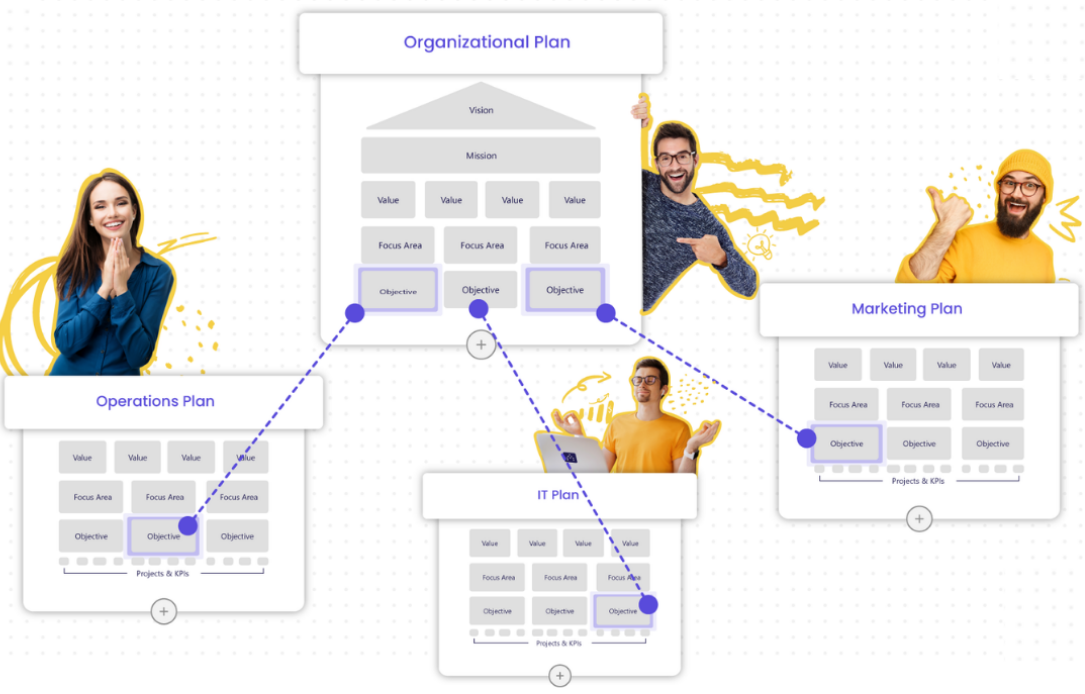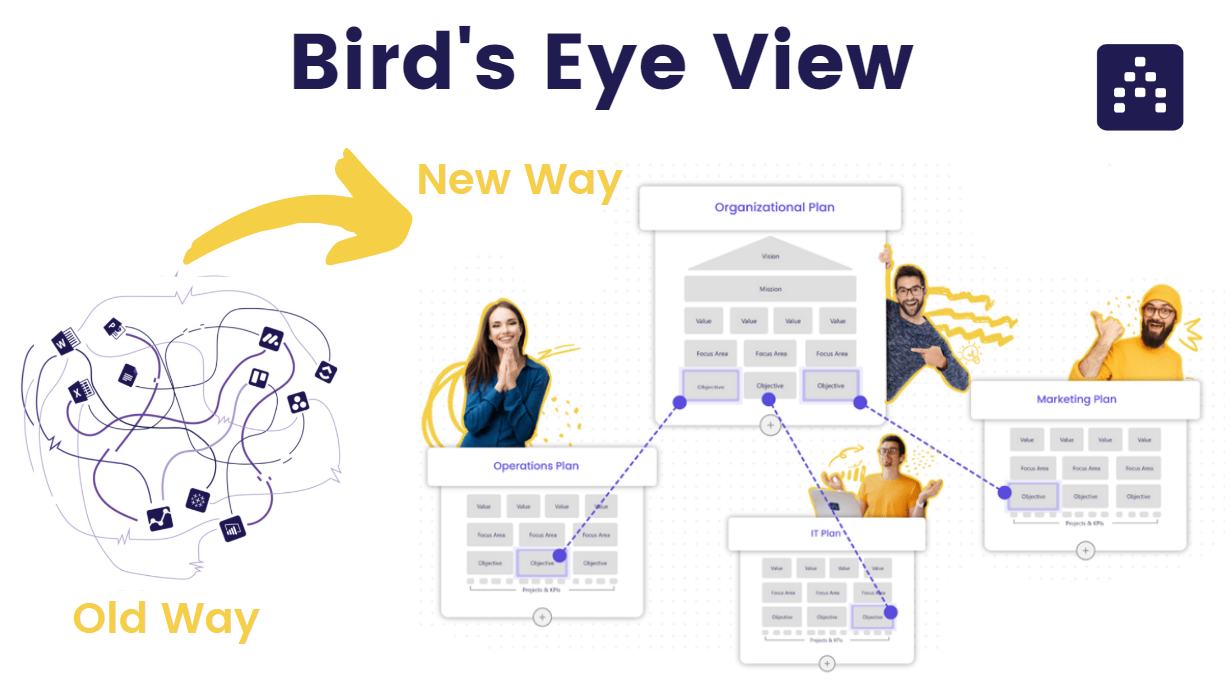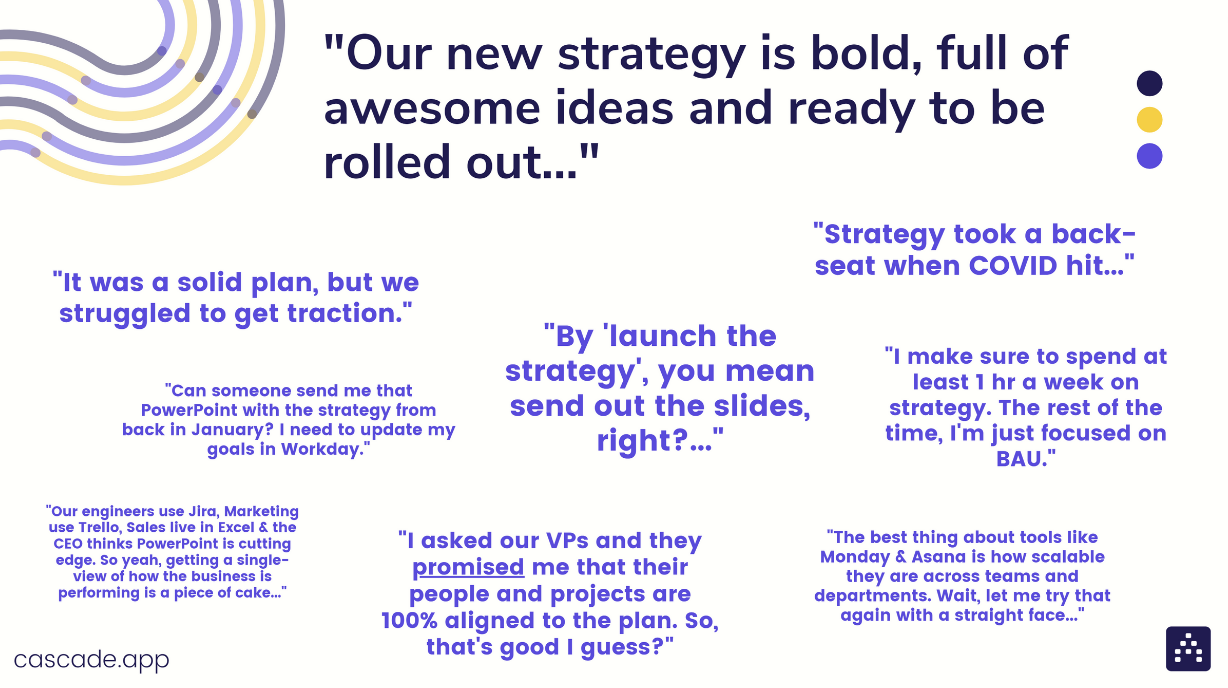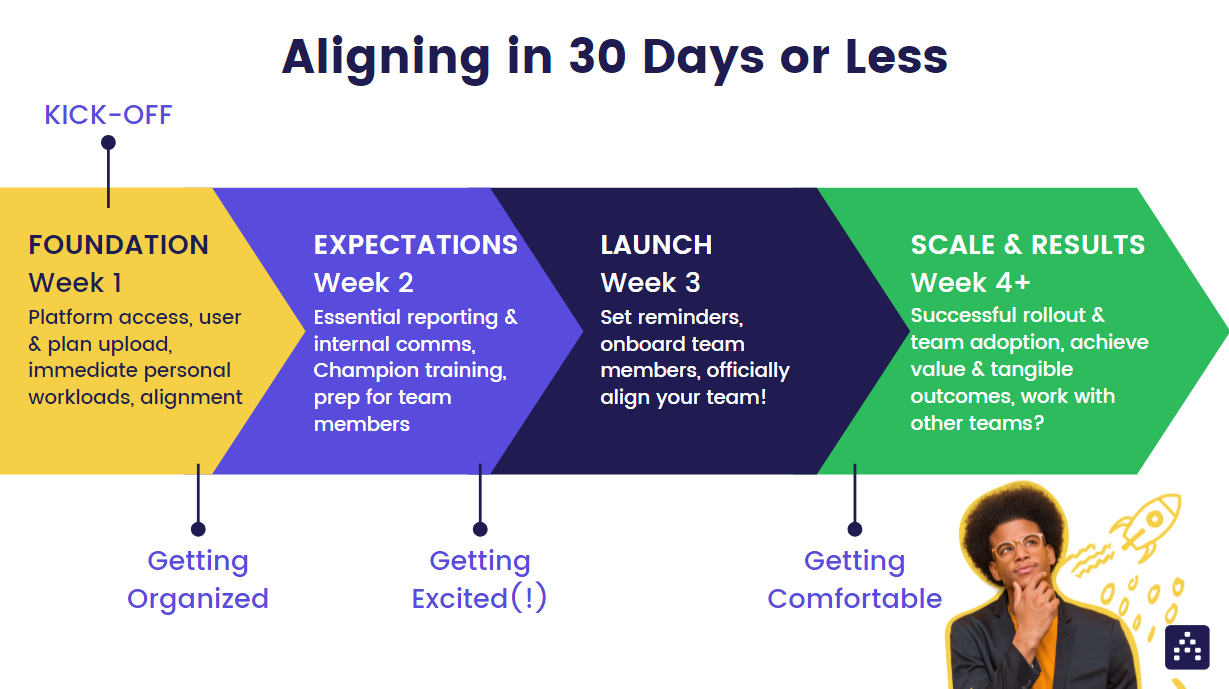Getting Buy-in: Effective Sponsors
Effective sponsors lead the organization through change management as role models and the face and voice of the change. In fact, active and visible sponsorship has been identified as the #1 contributor to success in 20 years of research on change management best practices [link].
When a sponsor fails to fulfill their role, it can doom a proposed change. If the change in your organization is going to be around strategy execution, that failure can have incredibly negative consequences!
People often find Cascade because they are thought leaders in their organization. They have the drive to see the big picture and to execute their strategy, but sometimes they don't have the authority to implement Cascade widely. All employees involved need to share a common purpose, driven by leadership and facilitated by Cascade.
This is why finding an effective sponsor as a spearhead of accountability will benefit your strategy's likelihood of being executed. Without a clear, authoritative "Why" behind the change, people will feel lost. Trust your people with clear expectations, and ensure they know the change is real!
Find Sponsors
The best-possible sponsors are executive sponsors in leadership, for obvious reasons. You might be the sponsor for your individual team!
Regardless of who it may be, it's important to find the correct sponsor(s) for the job depending on the scope. Once you have a few in mind, ask yourself these questions:
-
On a scale of 1 (least) to 5 (most): To what extent would the organization (employees and managers) listen to and respect communications and support from this leader?
-
On a scale of 1 (least) to 5 (most): What is his/her ability to provide resources and funding to the project?
-
On a scale of 1 (least) to 5 (most): How much direct control does this sponsor have over the people and processes impacted by using Cascade?
-
On a scale of 1 (least) to 5 (most): How much direct control does this sponsor have over the systems and tools impacted by strategy execution?
-
On a scale of 1 (least) to 5 (most): What is this person's capacity to sponsor and commit to Cascade?
If the sponsor you've decided on ranks highly here, they're an awesome candidate for effective sponsorship. Now comes the hard part: securing them for the job!
How to Pitch Cascade to your Sponsor
When approaching a possible sponsor, make sure to cover the following:
-
How Cascade will benefit them & the organization
-
What kind of work will be required of them
-
Why you need them
(1) How Cascade will benefit them
"What's in it for me?"
This is such an important starting point for sponsors, especially those in executive leadership. Any candidate for sponsorship has valuable time, so you need to prove that committing to the change as a sponsor, even minimally, is a good investment for themselves and the bigger picture.
Those in leadership have an inherent need to make sure their employees are focusing on the right things in a coherent way, and Cascade is a perfect way to keep that work organized and make the sponsor look good in the process!
Being able to instantly get insights to see how the organization is dynamically managing strategy from top to bottom saves a ton of time in these areas:
-
Chasing down progress updates across teams.
-
Reconciling inconsistent documents.
-
Creating presentable KPI and progress reports.
-
Adjusting strategy proactively, rather than playing from behind quarterly.
You might need to do some homework on this one, to be fair.
-
How does this sponsor currently review progress of the strategy (if at all)?
-
How do they prefer to talk about the strategy?
-
Are they eager (not just open) to make the organization and your people better?
-
Is now the right time for the change, given other priorities? If not, when?
There are plenty of variables to consider here, but just remember the key questions to keep in mind when asking for sponsorship, depending on who they are:
-
"What's in it for me?"
-
"What's in it for our team?"
-
"What's in it for our organization?"
(2) What kind of work will be required
When approaching a sponsor, it's essential to be explicit in what will be required of them. If the expectations are clear and memorable, it will be easier for your sponsor to consider the idea and make a decision.
Generally speaking, you will definitely want the sponsor to be visible throughout the change management process. Even if he/she only attends key meetings and gets the rest of his/her updates behind the scenes, that visibility among employees goes a long way. It says "This is real. We're all accountable to this and we need results."
(3) Why you need them
Change happens most easily with good leadership backing it! Make sure it's clear how and where having sponsorship buy-in will make the entire process easier and more efficient, while emphasizing how you and the team(s) will step up to make it happen.
Sometimes this is just a matter of hierarchy in the org chart, and other times it's more about aligning on a message that clearly explains the benefits of the change regardless of position. An effective sponsor will be able to validate and even amplify that message!
So what should this pitch look like?
As mentioned before, time is often very valuable for potential sponsors. That's why all of this information needs to be presented in a format that is as clear and concise as possible.
Overview:
Common quotes we've heard:
Folks in executive leadership particularly tend to prefer short and visual messaging that is immediately understandable. Try your best to prepare so that you can deliver the message in 5 minutes:
-
Call out the problem you're trying to solve, and explain the solution.
-
Appeal to them individually, and connect that appeal to the bigger picture ("What's in it for me?").
-
Explain what preparation has been done so far, and what immediate next steps would be.
-
Explain why their involvement is essential.
-
Use a few key visualizations of some kind for emphasis.
Be prepared to discuss for longer, but expect to not have much more than that for the first discussion.
It might sound hard, but being able to shorten your messages in this way is an excellent skill to have no matter what, and it can be tough to predict how much time you'll end up having regardless of what's on the calendar!
It's as Thomas Jefferson once said:
“The most valuable of all talents is that of never using two words when one will do.”
What if I can't get a sponsor?
If you're not able to get a strong sponsor at first, it's not the end of the world. This creates an opportunity to perhaps start small and figure out what kind of progress needs to be made in order to get sponsors' interest.
Perhaps if one team or group demonstrates good outcomes as a result of the change, for example, that will create more incentive and confidence for potential sponsors. Or you might need to clear up your messaging a bit to make it as concise and clear as possible. Sometimes having more people join your effort in seeking sponsorship collectively can also be effective.
At the end of the day, if a sponsor can't be added to the project to push more effective change management, success is still possible. Keep each of the guidelines in this document in mind as you go along so that you can always be ready to get buy-in from potential sponsors as you go.
Great - I have a sponsor! Now what...
Now the real momentum can start building. With sponsored support, you can create a simple - but robust - communication plan. For a full overview of what launching and communicating your strategy can look like, check out this article.
Sometimes the first major step is to simply announce Cascade as the organization's platform of choice (sent by your sponsors). Setting the tone this way is extremely powerful, especially with a specific (if high level) timeline to back it up.
Building awareness and excitement around a big change should be done deliberately and gradually, so that when the timeline officially begins, you can be as efficient as possible in execution. Here's a visual we like to provide when explaining how implementation can progress for Cascade:
If it helps, see below for a basic announcement email example:
~~~
Good morning/afternoon/evening,
As you may have heard, our team is in the process of implementing the strategy planning and execution software called Cascade.
What is Cascade?
Simply put, Cascade is an intuitive, visual, Cloud-based platform that will allow our team to plan, manage, and track the progress of our strategic plan and initiatives.
Not just another tool, Cascade will allow us to:
-
Consolidate all our strategic objectives, projects, and KPIs in one place.
-
Manage a top-down strategic plan via bottom-up results.
-
Provide full transparency with genuine accountability.
-
Visualize our entire organization’s activities.
-
Create customized reports to be reviewed in real-time.
Why did I receive an invite?
-
To track how we are doing overall, we need to map and consistently update the progress of our projects and initiatives. These will in turn feed up to our overarching strategy.
Obtaining access:
-
You should receive an email inviting you to log into Cascade by [insert date/time here].
-
If you have any trouble logging in, please reach out to [first & last name and email of internal contact] for assistance.
-
Check your spam folder if you do not receive this email by [insert date/time here].
Okay I’m in – now what?
Once you can successfully access the system, feel free to log in and start clicking around. You do not need to upload or update anything yet, however you can:
-
Review your associated goals.
-
Update information (e.g. description, tasks, etc.)
-
Peruse the strategic plans at various levels and reporting functionalities.
We will be hosting a user training session in the coming weeks where we will cover the above – thank you for your participation and as always, please let us know if you have any questions/comments.
[Sponsor Name]
This article will be reviewed and augmented as we learn better best practices.
For more, check out our "Mobilize Your Team" course in the Cascade Academy (will need to create an account, but it's very quick!).
.png?width=200&height=80&name=Classic%20Experience%20(1).png)





